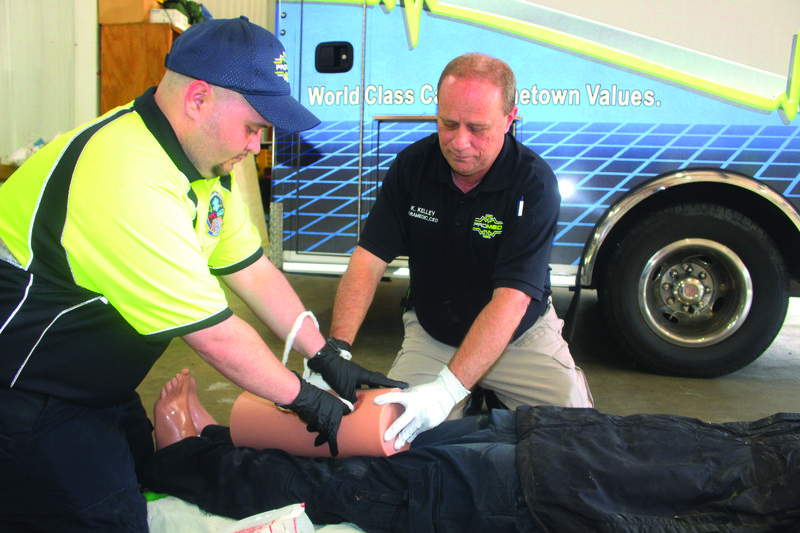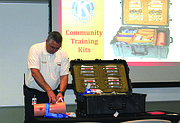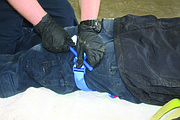Uncontrolled bleeding is the number one cause of preventable death from a trauma event.
“It’s not broken bones. It’s not the head, neck and spine injuries that we often hear about,” said Ken Kelley, ProMed Ambulance CEO. “Most of the trauma deaths result in something that you could handle with your two hands … and that’s uncontrolled bleeding.”
The El Dorado Kiwanis Club, El Dorado Fire Department and ProMed Ambulance have partnered together bring the “Stop the Bleed” campaign to El Dorado.
The Stop the Bleed campaign was started after a committee met in Hartford Connecticut to research intentional mass causality events and how to increase survival. The Hartford Consensus includes the opinions of a multidisciplinary committee involving medical groups, the military, the National Security Council, Homeland Security, the FBI, law enforcement, fire rescue and EMS.
The main principle of the Hartford Consensus is that no one should die from uncontrolled bleeding and that all citizens should learn to stop bleeding.
Stop the Bleed is a national awareness campaign, which encourages bystanders to become trained and equipped to help in a bleeding emergency before professional help arrives.
When an uncontrollable bleeding incident takes place, responding in the first three to four minutes are critical for survival. The average response time for law enforcement in the city is about four minutes. The average response time for an incident outside of city limits is about 14 minutes.
“We know that we can’t have an ambulance on every corner,” Kelley said. “We know that in rural populations we have response times that are going to have to be accounted for, so we’re going to have to rely on citizen responders to take care of patients until help can arrive.”
The larger vessels in the upper part of the leg and upper arms and in the neck are usually the ones that when injured are mostly likely to cause a person to bleed out in three to four minutes. A person can lose 20 percent of blood volume in about two to three minutes, which is when it become dangerous.
Stop the Bleed’s primary principles of trauma care response are broken down into three categories that HomeLand Security created:
A) Alert: call 911
B) Bleeding: find the bleeding injury
C) Compress: apply pressure to stop the bleeding.
After you find the bleeding injury, Stop the Bleed focuses on two types of wounds: puncture wounds and lacerations.
A puncture wound is a hole that goes into the body, possibly puncturing a blood vessel. To stop this type of bleeding, cover the wound in a clean cloth and put a hand over the wound to apply pressure.
A laceration is a long cut that a hand might not be able to cover completely. To stop this bleed, you must use the “wound packing” technique, which is packing the laceration with gauze or clean cloth until the bleeding is controlled.
If the bleeding does not stop, and it is coming from an arm or a leg, a tourniquet might be the best option to stop the bleeding. A tourniquet is a tight band that completely cuts off the blood flow by placing the band above the wounded area.
The Stop the Bleed kits include gauze and tourniquets (plus much more) but if a tourniquet is not available, makeshift tourniquets can be used. The tourniquet should be at least two to three inches above the injury or as close to where the arm or leg joins the body. Do not put a tourniquet around the neck.
“The goal is to stop the flow or plug the hole,” Kelley said.
Tourniquets are very painful and they cannot be too tight.
El Dorado Fire Chief Chad Mosby said that in the past it was known that if you put a tourniquet on, then there’s only a short amount of time that the limb can be save.
“Now with advances in trauma surgery and micro surgery, that tourniquet can be on and that blood supply be cut off for up to four hours with no injury to the limb,” Mosby said. “Anywhere in Arkansas, we can have you to a level one trauma center in four hours. Don’t hesitate putting those tourniquets on.”
When using a makeshift tourniquet, avoid using narrow material like shoe laces or electrical cords. The recommended width of a material is at least the width of a belt. The most important part when using a tourniquet is placing something long underneath it and turning it. With tourniquets included in the Stop the Bleed kits, there is a instrument called a windless that you twist to tighten the tourniquet. This pulls everything in a complete circle and provides pressure all the way around the extremity.
If an injury is in a place where you cannot put a tourniquet, like the chest, wound packing is the best thing you can do to stop that bleeding. Using gauze is preferred, but using a clean material like a shirt or a scarf can stop the bleeding.
Kelley said the Hartford Consensus looked at the amount of infections caused by emergent first aid and it was found to be less than three percent.
“You’re going to get treatment for a potential infection anyway if you’ve had an open wound injury,” Kelley said. “The key is to keep packing. You pack and pack and keep packing. If you run out of material, you find some more and you pack it until you cannot physically pack anything else.”
Before offering help to someone with an injury, first insure your own safety. Only provide care to the injured person if the scene is safe.
Life threatening bleeding can be determined if:
• Blood is spurting out of the wound
• Blood won’t stop coming out of the wound
• Blood is pooling on the ground
• Bandages are soaked with blood
• Clothing is soaked in blood
• Loss of all or part of an arm or leg
• A bleeding victim is confused or unconscious
Also, when treating a bleeding victim it is best to wear gloves, if available, to protect yourself from blood born infections. Kelley said more research over the last 30 years has been found that the transmission of communicable disease is not as great as what was believed it would be, as long is the responder doesn’t have visible injuries.
“A lot of people were hesitate to provide first aid because they didn’t feel like they were properly equipt,” Kelley said. “Blood born pathogens are always a concern but it has to be a calculated risk … is it better to have that person bleed out in a matter of two minutes and not take action, or is it better to take action and protect yourself as much as you can?”
The first response training, which was started almost 20 years ago, was referred to as “first generation training.” The first generation training is what was used during the Columbine High School shooting on April 20, 1999. The training was that everyone was to stay outside until the scene was completely secure. It was more than two hours before law enforcement were able to enter the school. Kelley said this practice was used up until a few years ago.
The second generation training cut that two hour time down to 52 minutes with the Orlando Florida night club shooting.
After the Orlando night club shooting, the third generation training was enforced, which is “whoever arrives on that scene first, goes in and begins to neutralize the threat,” Kelley said.
“Take care of the situation and then begin treating victims that are found, whatever the situation may be,” he said. “We’ve cut the average response time down to about four minutes.”
The main situation that brought this to attention was the Boston Marathon bombing, where civilian responders used makeshift things, such as t-shirts and neck scarfs, which were handed out to everyone at the beginning of the race. The scarfs were used as tourniquets that were placed immediately by citizens.
Anyone who has received Stop the Bleed training is considered an “immediate responder.”
If the third generation training had taken place when the Columbine High School shooting happened, Kelley said 11 out of the 13 students may have been saved. Only two had torso injuries, but the other 11 were in the arm or leg and “could have been easily handled by someone getting in there and putting direct pressure” on the wounds.
In the future, Kelley said most public buildings will have a Stop the Bleed kit next to the fire extinguishers.
“That’s what one of our goals here is to have more ready access and more supplies and equipment in places where victims of injury may likely occur,” he said. “It’s also important that you be prepared in your homes and in your vehicles to protect yourself and your family.”
Kelley said that they are still following the “Run, Hide and Fight” campaign that has always been taught in schools and businesses. “In the event that there is an active assailant situation, it’s always best to get away,” he said. “If you can run, run. If not, stand your ground and try to hide and if you’re confronted with the assailant, fight.”
Kelley also said if you can move the victim safely, then do so. This goes against the training they were always taught that if someone is injured, do not move them. Kelley added that a lot of times people are not moving victims that could be moved if there are other dangers that still existed.
Schools are beginning to start Stop the Bleed training in America. Kelley said in August, all of the school nurses in Arkansas will be offered free training and will be able to take it back to their schools.
Stop the Bleed trauma kits range from $7 to $30 and are available at stopthebleedingcoalition.org.
With the help from the El Dorado Kiwanis Club and other grant fundings, Kelley said they were able to purchase a training kit that “could easily train thousands of people.”
Little Rock began using the Stop the Bleed campaign over a year and a half ago, and Kelley said Little Rock already has 15 recorded saves.
Kelley and Mosby plan to schedule monthly trainings for the campaign in El Dorado. To find out more information, contact the El Dorado Fire Department or ProMed.
“The picture you’ve always seen is someone is injured, and they are mainly relying on the professional rescuers and the extended medical staff at the hospital to save the life,” Mosby said. “Now we’re going to see that change with the Hartford Consensus report. Whether it’s workplace violence, school shootings or a workplace or home injury, that whole paradigm shifts to the point where that person standing next to me is now trained to stop that bleed and get the ball rolling.”
Kaitlyn Rigdon can be reached at 870-862-6611 or [email protected].


